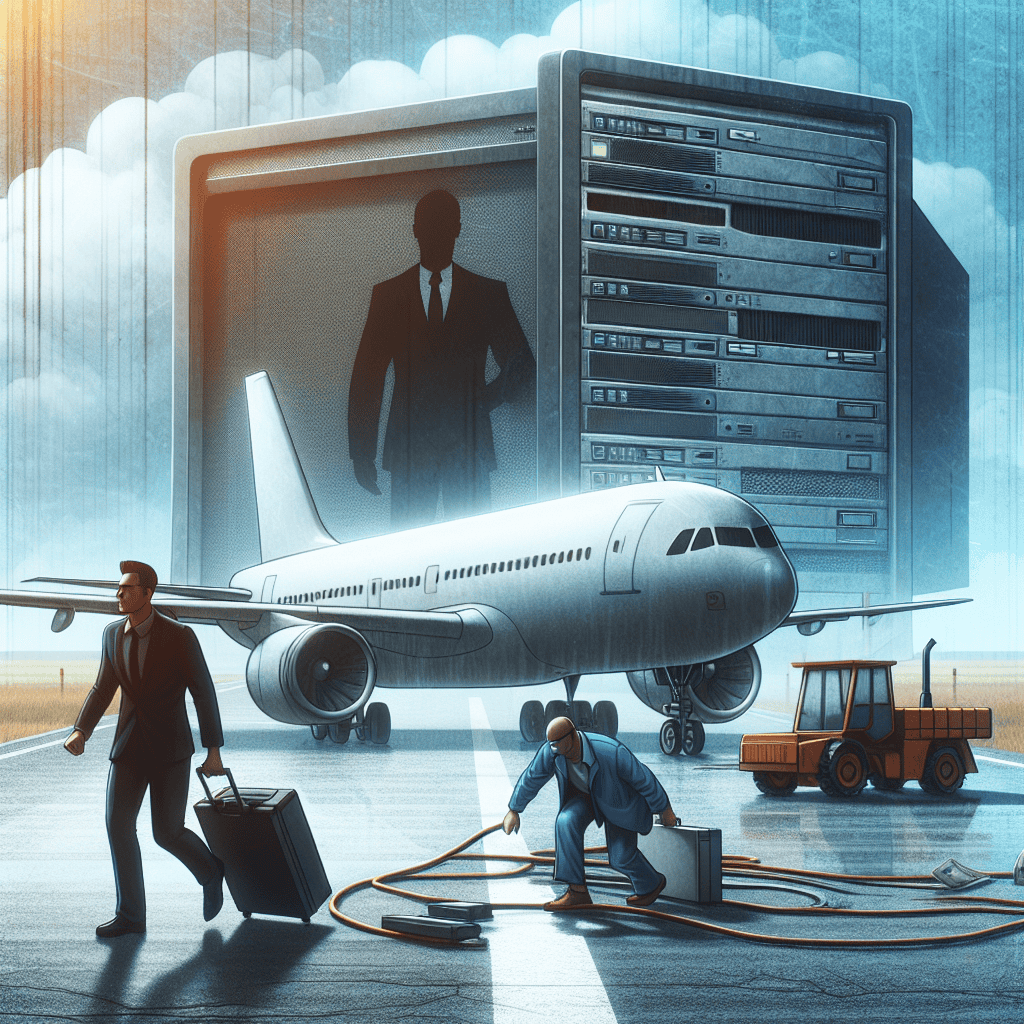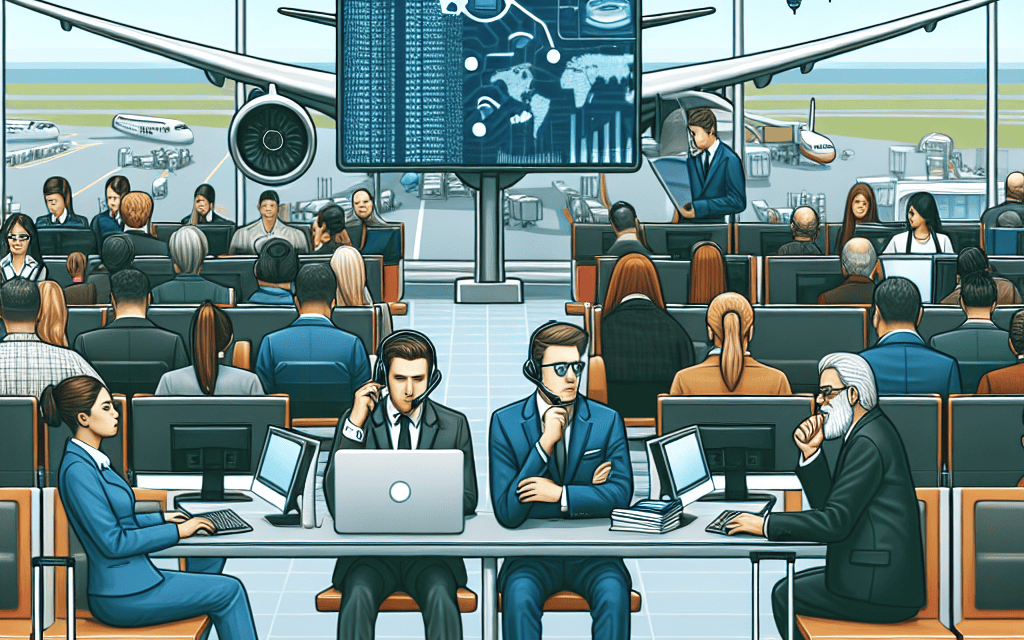“Delta Grounds Flights, Takes Legal Flight Against CrowdStrike Over Software Turbulence”
Introduction
Delta Air Lines has initiated legal proceedings against cybersecurity firm CrowdStrike after a software update allegedly led to significant disruptions in the airline’s operations. The update reportedly caused widespread flight delays, affecting thousands of passengers and resulting in substantial financial and reputational damage to Delta. The lawsuit claims that CrowdStrike’s software malfunctioned, leading to critical system failures within Delta’s IT infrastructure. This legal action underscores the growing reliance of major corporations on third-party technology providers and the potential risks involved when these systems fail. Delta seeks compensation for the losses incurred and aims to hold CrowdStrike accountable for the disruption caused by the software update.
Legal Implications Of Software Failures In The Aviation Industry
In recent developments within the aviation industry, Delta Air Lines has initiated legal proceedings against cybersecurity firm CrowdStrike, following a software update that allegedly led to widespread flight delays. This incident underscores the critical importance of reliable software systems in the aviation sector, where even minor disruptions can have far-reaching consequences. As airlines increasingly rely on sophisticated software to manage operations, the legal implications of software failures have become a pressing concern.
The aviation industry is heavily dependent on technology to ensure the smooth operation of flights, from scheduling and maintenance to passenger services and security. Consequently, any malfunction in these systems can result in significant operational disruptions. In Delta’s case, the software update provided by CrowdStrike was intended to enhance cybersecurity measures. However, it reportedly caused unexpected system outages, leading to delays that affected thousands of passengers. This situation highlights the delicate balance between implementing necessary security measures and maintaining operational efficiency.
Legal action in such scenarios often revolves around the terms of the contract between the airline and the software provider. Typically, these contracts include clauses that outline the responsibilities of each party, including the provision of timely updates and the assurance of minimal disruption to services. Delta’s lawsuit against CrowdStrike is likely to focus on whether the cybersecurity firm breached these contractual obligations. Furthermore, the case may explore whether CrowdStrike exercised due diligence in testing the update before its deployment.
The legal implications extend beyond contractual disputes, as software failures in the aviation industry can also raise questions of liability. In the event of a system failure that leads to flight delays or cancellations, airlines may face claims from passengers seeking compensation for their inconvenience. Consequently, airlines may seek to recover these costs from the software provider if it is determined that the failure was due to negligence or a breach of contract. This potential for cascading liability underscores the importance of robust risk management strategies in software deployment.
Moreover, this incident serves as a reminder of the broader regulatory environment governing the aviation industry. Regulatory bodies, such as the Federal Aviation Administration (FAA) in the United States, impose stringent requirements on airlines to ensure safety and reliability. Software providers must ensure that their products comply with these regulations, as non-compliance can result in severe penalties and reputational damage. The Delta-CrowdStrike case may prompt regulators to scrutinize the processes by which software updates are tested and implemented, potentially leading to more stringent oversight.
In addition to legal and regulatory considerations, the incident raises questions about the role of cybersecurity in the aviation industry. As cyber threats become increasingly sophisticated, airlines must continually update their systems to protect against potential breaches. However, this need for constant vigilance must be balanced with the imperative to maintain uninterrupted service. The Delta case illustrates the challenges that airlines and their software partners face in navigating this complex landscape.
In conclusion, the legal action taken by Delta against CrowdStrike following a disruptive software update highlights the intricate interplay between technology, law, and regulation in the aviation industry. As airlines continue to integrate advanced software solutions into their operations, the potential for legal disputes over software failures is likely to grow. This case serves as a cautionary tale for both airlines and software providers, emphasizing the need for meticulous planning, rigorous testing, and clear contractual agreements to mitigate the risks associated with software deployment.
The Role Of Cybersecurity In Aviation: A Case Study Of Delta And CrowdStrike
In the ever-evolving landscape of aviation, cybersecurity has emerged as a critical component in ensuring the safety and efficiency of airline operations. The recent legal action taken by Delta Air Lines against cybersecurity firm CrowdStrike underscores the intricate relationship between technology providers and the aviation industry. This case highlights the profound impact that cybersecurity software can have on airline operations, particularly when updates or changes lead to unforeseen consequences.
Delta’s lawsuit against CrowdStrike stems from a software update that reportedly caused widespread flight delays, affecting thousands of passengers and disrupting the airline’s operations. This incident serves as a poignant reminder of the reliance airlines have on sophisticated cybersecurity systems to protect their digital infrastructure. As airlines increasingly depend on digital systems for everything from flight scheduling to customer service, the role of cybersecurity becomes paramount. The integration of these systems is designed to enhance operational efficiency and protect sensitive data from cyber threats. However, as demonstrated by the Delta-CrowdStrike case, any malfunction or misstep in these systems can lead to significant operational challenges.
The aviation industry is particularly vulnerable to cyber threats due to its complex and interconnected nature. Airlines must safeguard a vast array of data, including passenger information, flight plans, and communication systems. Consequently, they rely heavily on cybersecurity firms to provide robust protection against potential breaches. In this context, the relationship between airlines and cybersecurity providers is one of mutual dependence. Airlines depend on these firms to ensure the integrity and security of their operations, while cybersecurity companies rely on airlines as key clients in a competitive market.
The Delta-CrowdStrike incident also raises important questions about accountability and risk management in the aviation sector. When a software update leads to operational disruptions, determining responsibility can be challenging. In this case, Delta’s decision to pursue legal action suggests a belief that CrowdStrike’s update was the primary cause of the delays. This situation underscores the need for clear communication and collaboration between airlines and their cybersecurity partners. Establishing protocols for testing and implementing software updates can help mitigate risks and prevent similar incidents in the future.
Moreover, this case study highlights the broader implications of cybersecurity in aviation. As airlines continue to adopt new technologies, the potential for cyber-related disruptions increases. This necessitates a proactive approach to cybersecurity, where airlines and their partners work together to anticipate and address potential vulnerabilities. By fostering a culture of continuous improvement and vigilance, the aviation industry can better protect itself against the ever-present threat of cyberattacks.
In conclusion, the legal action taken by Delta against CrowdStrike serves as a stark reminder of the critical role cybersecurity plays in the aviation industry. As airlines become more reliant on digital systems, the potential for cyber-related disruptions grows. This case underscores the importance of strong partnerships between airlines and cybersecurity firms, as well as the need for clear protocols and communication channels. By learning from incidents like this, the aviation industry can enhance its resilience against cyber threats and ensure the continued safety and efficiency of its operations. As technology continues to advance, the importance of cybersecurity in aviation will only increase, making it an essential focus for airlines and their partners moving forward.
How Software Updates Can Impact Airline Operations: Lessons From Delta’s Experience
In the ever-evolving landscape of technology, software updates are a routine yet critical component of maintaining operational efficiency and security. However, the recent legal action taken by Delta Air Lines against cybersecurity firm CrowdStrike highlights the potential pitfalls that can arise when these updates do not go as planned. This incident serves as a poignant reminder of the intricate relationship between software systems and airline operations, underscoring the importance of meticulous planning and execution in the deployment of software updates.
Delta’s legal action stems from a software update provided by CrowdStrike that reportedly led to widespread flight delays, affecting thousands of passengers and causing significant operational disruptions. The airline alleges that the update, intended to enhance cybersecurity measures, inadvertently interfered with critical systems, leading to a cascade of technical issues. This situation illustrates the complex web of dependencies that exist within airline operations, where even minor software changes can have far-reaching consequences.
Airlines rely heavily on a multitude of interconnected software systems to manage everything from flight scheduling and crew assignments to passenger check-in and baggage handling. These systems must operate seamlessly to ensure that flights depart and arrive on time, and any disruption can lead to a domino effect, impacting not only the airline but also passengers and airport operations. In Delta’s case, the software update’s unintended consequences highlight the need for rigorous testing and validation processes before any changes are implemented in a live environment.
Moreover, this incident underscores the importance of collaboration and communication between airlines and their technology partners. Effective partnerships require a clear understanding of the airline’s operational needs and the potential risks associated with software updates. By fostering open lines of communication, airlines and technology providers can work together to anticipate and mitigate potential issues, ensuring that updates enhance rather than hinder operational efficiency.
In addition to technical considerations, the Delta-CrowdStrike case also brings to light the legal and financial implications of software-related disruptions. Airlines operate in a highly competitive and regulated industry, where delays and cancellations can lead to substantial financial losses and damage to brand reputation. As such, airlines must carefully evaluate the terms of their contracts with technology providers, ensuring that they include provisions for liability and recourse in the event of software failures.
Furthermore, this situation highlights the need for airlines to develop robust contingency plans to address potential software-related disruptions. By having a comprehensive response strategy in place, airlines can minimize the impact of unforeseen technical issues, maintaining operational continuity and safeguarding passenger satisfaction. This includes investing in backup systems, training staff to handle technical emergencies, and maintaining clear communication channels with passengers during disruptions.
In conclusion, the legal action taken by Delta against CrowdStrike serves as a cautionary tale for the airline industry, emphasizing the critical role that software updates play in maintaining operational efficiency. It highlights the need for rigorous testing, effective collaboration, and comprehensive contingency planning to mitigate the risks associated with software changes. As airlines continue to navigate the complexities of modern technology, these lessons will be invaluable in ensuring that software updates enhance rather than disrupt their operations.
Navigating Legal Disputes Between Airlines And Tech Companies

In the ever-evolving landscape of aviation technology, the integration of advanced software systems is crucial for ensuring operational efficiency and safety. However, when these systems fail, the repercussions can be significant, as demonstrated by the recent legal dispute between Delta Air Lines and cybersecurity firm CrowdStrike. This conflict arose following a software update that allegedly led to widespread flight delays, highlighting the complex relationship between airlines and technology providers.
Delta Air Lines, a major player in the global aviation industry, relies heavily on sophisticated software to manage its operations. These systems are integral to scheduling, maintenance, and security, among other functions. In an era where cybersecurity threats are increasingly prevalent, Delta partnered with CrowdStrike, a leading cybersecurity company, to enhance its digital defenses. However, a recent software update from CrowdStrike reportedly caused significant disruptions, leading to flight delays and operational chaos.
The incident underscores the delicate balance airlines must maintain between embracing technological advancements and managing the risks associated with them. While technology can streamline operations and improve security, it also introduces vulnerabilities that can have far-reaching consequences. In this case, the software update, intended to bolster cybersecurity measures, inadvertently disrupted Delta’s operations, affecting thousands of passengers and tarnishing the airline’s reputation.
In response to the disruptions, Delta has taken legal action against CrowdStrike, seeking compensation for the financial losses incurred due to the flight delays. This legal move highlights the growing trend of airlines holding technology providers accountable for failures that impact their operations. As airlines become increasingly dependent on third-party software solutions, the potential for legal disputes over service disruptions is likely to rise.
Navigating these legal disputes requires a nuanced understanding of both aviation and technology sectors. Airlines must ensure that their contracts with technology providers include clear terms regarding liability and service level agreements. These agreements should outline the responsibilities of each party in the event of a system failure, providing a framework for resolving disputes without resorting to litigation.
Moreover, this incident raises important questions about the testing and implementation of software updates in critical systems. It is essential for technology providers to conduct rigorous testing and collaborate closely with their clients to minimize the risk of disruptions. Airlines, on their part, must establish robust contingency plans to mitigate the impact of any potential software failures.
The Delta-CrowdStrike dispute also serves as a reminder of the importance of communication and transparency between airlines and their technology partners. Open lines of communication can help identify potential issues before they escalate into major disruptions. By fostering a collaborative relationship, both parties can work together to address challenges and enhance the overall reliability of aviation systems.
In conclusion, the legal action taken by Delta against CrowdStrike following a disruptive software update highlights the intricate relationship between airlines and technology providers. As the aviation industry continues to embrace digital transformation, the potential for conflicts over software failures is likely to increase. To navigate these challenges, airlines and technology companies must prioritize clear contractual agreements, rigorous testing protocols, and open communication. By doing so, they can mitigate risks and ensure that technological advancements continue to enhance, rather than hinder, the efficiency and safety of air travel.
The Importance Of Risk Management In Airline Software Deployments
In the ever-evolving landscape of aviation technology, the importance of risk management in software deployments cannot be overstated. This principle has been starkly highlighted by the recent legal action taken by Delta Air Lines against cybersecurity firm CrowdStrike. The lawsuit follows a software update that allegedly led to widespread flight delays, underscoring the critical need for meticulous planning and risk assessment in the deployment of new technologies within the airline industry.
Airlines, by their very nature, operate in a highly complex and interconnected environment where even minor disruptions can have cascading effects. The integration of new software systems, therefore, requires a comprehensive understanding of potential risks and the implementation of robust mitigation strategies. In the case of Delta, the software update provided by CrowdStrike was intended to enhance cybersecurity measures. However, the unforeseen consequences of this update resulted in significant operational disruptions, affecting thousands of passengers and leading to substantial financial losses.
This incident serves as a poignant reminder of the delicate balance that must be maintained between innovation and operational stability. While the adoption of cutting-edge technologies is essential for maintaining competitive advantage and ensuring passenger safety, it must be approached with caution. Effective risk management strategies are crucial in identifying potential vulnerabilities and ensuring that contingency plans are in place to address any issues that may arise.
Moreover, the Delta-CrowdStrike case highlights the importance of collaboration and communication between airlines and their technology partners. Successful software deployments require a deep understanding of the airline’s operational environment and the potential impact of new technologies on existing systems. This necessitates a collaborative approach, where both parties work closely to identify potential risks and develop strategies to mitigate them. In this context, clear communication and transparency are vital to ensuring that all stakeholders are aware of potential challenges and are prepared to address them effectively.
Furthermore, the incident underscores the need for rigorous testing and validation processes prior to the implementation of new software systems. Comprehensive testing can help identify potential issues and allow for the development of solutions before they impact operations. This is particularly important in the airline industry, where the stakes are high and the margin for error is minimal. By investing in thorough testing and validation processes, airlines can reduce the likelihood of disruptions and ensure a smoother transition to new technologies.
In addition to these technical considerations, the Delta-CrowdStrike case also raises important questions about accountability and liability in the event of software-related disruptions. As airlines increasingly rely on third-party vendors for critical technology solutions, it is essential to establish clear contractual agreements that outline the responsibilities of each party and provide mechanisms for resolving disputes. This can help protect airlines from financial losses and ensure that vendors are held accountable for the performance of their products.
In conclusion, the legal action taken by Delta against CrowdStrike serves as a powerful reminder of the importance of risk management in airline software deployments. By prioritizing collaboration, communication, and rigorous testing, airlines can better navigate the complexities of integrating new technologies and minimize the risk of operational disruptions. As the aviation industry continues to evolve, these principles will remain essential for ensuring the safe and efficient operation of airline services worldwide.
Analyzing The Impact Of Technology On Airline Reliability And Customer Trust
In recent developments, Delta Air Lines has initiated legal proceedings against cybersecurity firm CrowdStrike, following a software update that allegedly led to widespread flight delays. This incident underscores the intricate relationship between technology and the airline industry, highlighting both the potential benefits and risks associated with digital advancements. As airlines increasingly rely on sophisticated software systems to enhance operational efficiency and customer experience, the reliability of these technologies becomes paramount. The Delta-CrowdStrike case serves as a poignant reminder of the vulnerabilities that can arise when technological systems fail to perform as expected.
The airline industry, known for its complex logistical operations, has embraced technology to streamline processes, improve safety, and enhance customer service. From booking systems to in-flight entertainment and real-time flight tracking, technology plays a crucial role in ensuring smooth operations. However, the reliance on digital systems also introduces new challenges, particularly when these systems encounter glitches or malfunctions. In Delta’s case, the software update provided by CrowdStrike was intended to bolster cybersecurity measures. Instead, it reportedly caused significant disruptions, leading to flight delays and impacting thousands of passengers.
This incident raises important questions about the balance between technological innovation and operational reliability. While advancements in software and cybersecurity are essential to protect sensitive data and maintain the integrity of airline operations, they must be implemented with caution. The repercussions of a malfunctioning system can be far-reaching, affecting not only the airline’s schedule but also its reputation and customer trust. In an industry where punctuality and reliability are critical, any disruption can have a cascading effect, leading to financial losses and diminished customer satisfaction.
Moreover, the legal action taken by Delta against CrowdStrike highlights the complexities of accountability in the digital age. Determining liability in cases where software failures lead to operational disruptions can be challenging. It involves assessing the contractual obligations between the airline and the software provider, as well as understanding the technical intricacies of the systems involved. This case may set a precedent for how similar disputes are handled in the future, emphasizing the need for clear agreements and robust testing protocols before deploying critical software updates.
In addition to legal and operational considerations, the incident also impacts customer trust. Passengers expect airlines to provide reliable service, and any deviation from this expectation can lead to dissatisfaction and loss of loyalty. In an era where social media amplifies customer experiences, both positive and negative, airlines must be vigilant in maintaining their reputation. The swift resolution of technical issues and transparent communication with affected passengers are essential strategies for mitigating the impact of such disruptions.
In conclusion, the Delta-CrowdStrike case serves as a cautionary tale for the airline industry, illustrating the delicate balance between embracing technological advancements and ensuring operational reliability. As airlines continue to integrate digital solutions into their operations, they must prioritize rigorous testing and contingency planning to prevent disruptions. Furthermore, clear communication and accountability frameworks are crucial in navigating the complexities of technology-related challenges. Ultimately, maintaining customer trust hinges on an airline’s ability to deliver consistent and reliable service, even in the face of technological setbacks.
Strategies For Airlines To Mitigate Risks From Third-Party Software Providers
In the ever-evolving landscape of aviation, airlines are increasingly reliant on third-party software providers to enhance operational efficiency and improve customer experience. However, this dependency also introduces significant risks, as demonstrated by the recent legal action taken by Delta Air Lines against cybersecurity firm CrowdStrike. Following a software update that led to widespread flight delays, Delta’s predicament underscores the critical need for airlines to develop robust strategies to mitigate risks associated with third-party software providers.
To begin with, airlines must prioritize comprehensive due diligence when selecting software partners. This involves not only evaluating the technical capabilities and track record of potential providers but also assessing their risk management practices and incident response protocols. By thoroughly vetting third-party vendors, airlines can ensure that they are partnering with companies that have a proven ability to deliver reliable and secure solutions. Furthermore, establishing clear contractual agreements that outline service level expectations and liability in the event of disruptions is essential. These contracts should include detailed provisions for software updates, maintenance schedules, and communication protocols to minimize the impact of unforeseen issues.
In addition to due diligence, airlines should implement rigorous testing and validation processes for any new software or updates before full-scale deployment. This can be achieved through a phased rollout approach, where updates are initially applied to a limited number of systems or routes. By doing so, airlines can identify potential issues in a controlled environment and address them before they affect the broader operation. Moreover, maintaining a robust backup and recovery plan is crucial. In the event of a software failure, having a well-defined contingency plan can help airlines quickly restore operations and minimize disruptions to passengers.
Another critical strategy is fostering strong collaboration and communication between airlines and their software providers. Establishing a partnership mindset, rather than a transactional relationship, encourages open dialogue and mutual understanding of each party’s needs and challenges. Regular meetings and joint risk assessments can help identify potential vulnerabilities and develop proactive measures to address them. Additionally, airlines should invest in ongoing training and development for their IT and operational staff to ensure they are equipped to manage and respond to software-related issues effectively.
Furthermore, airlines can benefit from leveraging industry best practices and standards to guide their risk management efforts. Organizations such as the International Air Transport Association (IATA) and the International Civil Aviation Organization (ICAO) provide valuable resources and frameworks for managing technology-related risks in aviation. By aligning with these standards, airlines can enhance their resilience and ensure they are adopting the latest advancements in cybersecurity and operational efficiency.
Finally, it is essential for airlines to maintain a customer-centric approach when dealing with disruptions caused by third-party software issues. Transparent communication with passengers, including timely updates and clear explanations of the situation, can help mitigate frustration and maintain trust. Offering compensation or alternative travel arrangements can also demonstrate a commitment to customer satisfaction and help preserve the airline’s reputation.
In conclusion, while third-party software providers play a vital role in modernizing airline operations, they also introduce potential risks that must be carefully managed. By adopting a comprehensive risk mitigation strategy that includes due diligence, rigorous testing, strong collaboration, adherence to industry standards, and a focus on customer experience, airlines can better navigate the complexities of technology integration and safeguard their operations against unforeseen disruptions.
Q&A
1. **What prompted Delta to take legal action against CrowdStrike?**
Delta took legal action against CrowdStrike following a software update that allegedly caused widespread flight delays.
2. **What was the nature of the software update issue?**
The software update reportedly led to disruptions in Delta’s operations, affecting their flight scheduling and causing delays.
3. **How did the software update impact Delta’s operations?**
The update caused significant disruptions, leading to widespread flight delays and operational challenges for Delta.
4. **What is Delta seeking through the legal action?**
Delta is likely seeking compensation for damages and operational losses incurred due to the software update issue.
5. **Has CrowdStrike responded to Delta’s legal action?**
As of now, there is no public statement from CrowdStrike regarding their response to Delta’s legal action.
6. **How widespread were the flight delays caused by the software update?**
The flight delays were described as widespread, indicating a significant impact on Delta’s flight operations.
7. **What are the potential implications of this legal action for CrowdStrike?**
The legal action could lead to financial liabilities for CrowdStrike and may impact their reputation and client trust.
Conclusion
Delta Air Lines has initiated legal proceedings against cybersecurity firm CrowdStrike following a software update that reportedly led to significant flight delays. The update, intended to enhance security measures, allegedly caused disruptions in Delta’s operational systems, impacting flight schedules and passenger services. Delta’s legal action seeks to address the financial and reputational damages incurred due to the delays, highlighting the critical importance of reliable software performance in the aviation industry. This case underscores the potential risks associated with software updates and the need for thorough testing and contingency planning to mitigate operational disruptions.





